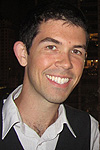Joe Grange receives 2014 URA Thesis Award
 |
|
Joe Grange
|
In 2008, Joe Grange, then a graduate student at the University of Florida, came to Fermilab to join the particle physics community in getting a better handle on the subtle neutrino.
Five years later, he produced a doctoral thesis that earned him this year's Universities Research Association Outstanding Thesis Award.
The award will be presented to Grange today at the Fermilab Users Meeting. URA annually bestows the award for work conducted at Fermilab or in collaboration with Fermilab scientists.
"The award conferred on Joe Grange honors both his achievement and the vital role that Fermilab plays in the education and training of the next generation of researchers," said Marta Cehelsky, URA executive director.
His work advances a field that has become the subject of the laboratory's leading program — the research of neutrinos, particles whose fleeting nature makes them an exceedingly difficult study.
"I didn't expect to be in the middle of this sort of blossoming field when I first started," Grange said. "I was still finding my way, but the team was so helpful, and I got guidance from these world experts."
As a member of the MiniBooNE experiment, Grange measured how often an antineutrino — specifically one of the three types called a muon antineutrino — reacted in the MiniBooNE detector.
The rare appearance of antineutrinos was only one challenge in measuring their cross section. One of the first tasks Grange tackled was developing and executing the first methods for measuring the neutrino background intrinsic to the antineutrino beam in a non-magnetized detector such as MiniBooNE.
Also, in order to increase the chances that a neutrino or antineutrino would interact in the detector, MiniBooNE used a relatively heavy substance for the particles to interact with. Earlier experiments' detectors were filled substances such as hydrogen, which has only one proton in its nucleus. MiniBooNE uses mineral oil, which has 14 neutrons and protons — 14 potential targets — for particles to interact with.
Scientists had to contend with the additional physics processes presented by the target's greater mass and complexity. Those processes may explain the discrepancy between models of antineutrino interactions and what MiniBooNE scientists had observed.
"At a meeting, one theorist stood up and exclaimed that the data was wrong, our conclusions were crazy," Grange said. "But in the year following, there were hints that these additional processes explained the discrepancy between theoretical predictions and what we saw."
Grange's data gives the neutrino community a powerful tool in calculating other neutrino properties, such as their oscillation — their ability to morph from one of their three types into another.
Grange completed his thesis, which was selected to be published in the Springer thesis series, in 2013 under University of Florida Professor Heather Ray. He is now a postdoc at Argonne National Laboratory working on Fermilab's Muon g-2 experiment.
"Joe is an innovative scientist and well deserving of the award," said Greg Bock, associate laboratory director for particle physics. "We are delighted he is continuing to work on experiments here at Fermilab."
—Leah Hesla
|